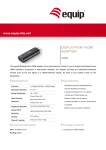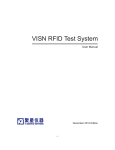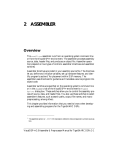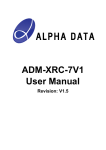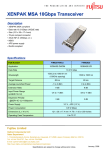Download TIP-VBY1HS Data Sheet
Transcript
TIP-VBY1HS-DS DATA SHEET Preliminary Preliminary TIP-VBY1HS Data Sheet V-by-One® HS Standard IP for Xilinx FPGA Rev.1.00 Tokyo Electron Device Ltd. Rev1.00 1 TIP-VBY1HS-DS Revision History The following table shows the revision history for this document. Revision Rev.1.0.0E Rev1.00 Date 2010/04/12 Comments First release 2 TIP-VBY1HS-DS Table of Contents 1. Introduction ......................................................................................................................5 2. Features...........................................................................................................................5 3. References ......................................................................................................................5 4. Specification outline .........................................................................................................6 5. Functional Overview ........................................................................................................7 5.1. Transmitter Core................................................................................................................ 7 5.2. Receiver Core .................................................................................................................... 8 6. I/O Signals .......................................................................................................................9 6.1. Transmitter Core................................................................................................................ 9 6.2. Receiver Core .................................................................................................................. 10 7. Reference Clock ............................................................................................................11 7.1. Clock Construction.......................................................................................................... 11 7.2. Recommended Board Design .......................................................................................... 12 8. Parameterization............................................................................................................13 9. Verification .....................................................................................................................13 9.1. Simulation........................................................................................................................ 13 9.2. Hardware Validation ....................................................................................................... 13 10. Family Support.............................................................................................................14 11. Technical Support ........................................................................................................14 12. Ordering Information ....................................................................................................14 Rev1.00 3 TIP-VBY1HS-DS Schedule of Figures Figure 5.1 Figure 5.2 Figure 7.1 Figure 7.2 Figure 7.3 Transmitter Core Block Diagram .......................................................................7 Receiver Core Block Diagram ...........................................................................8 TIP-VBY1HS Clock Construction ....................................................................11 Transmitter FPGA Recommended Board Design............................................12 Receiver FPGA Recommended Board Design................................................12 Schedule of Tables Table 4.1 Table 6.1 Table 6.2 Table 7.1 Table 7.2 Table 8.1 Rev1.00 TIP-VBY1HS Specification .................................................................................6 Transmitter Core I/O Signals ..............................................................................9 Receiver Core I/O Signals ................................................................................10 Virtex-6 GTX Reference Clock Characteristics.................................................11 Spartan-6 GTP Reference Clock Characteristics .............................................11 Parameterization Table ....................................................................................13 4 TIP-VBY1HS-DS 1. Introduction V-by-One® HS standard has been developed by THine Electronics,Inc. to offer capabilities for Flat Panel Display (FPD) markets that are requiring ever-higher frame rates and higher resolutions. The TIP-VBY1HS Core provided by Tokyo Electron Device Ltd.(TED) is a high performance, flexible solution for a high speed transmission of video signals designed to the V-by-One® HS standard for the Xilinx FPGA. State-of-the-art Virtex™-6 LXT / SXT and Spartan™-6 LXT are supported. 2. Features Protocol compliant with V-by-One® HS standard provided by THine Electronics, Inc. Independent Transmitter and Receiver module. Supports 1, 2, 4, and 8 lanes operations. Uses the GTP transceivers of Spartan-6 LXT families and the GTX transceivers LXT /SXT families. Supports up to 3.75Gbps data rate per lane (effective data rate 3Gbps) using Virtex-6 GTX transceiver. (up to 3.125Gbps using Spartan-6 GTP transceivers) Elastic buffers and Lane alignment Data scrambling and Clock Data Recovery (CDR) to reduce EMI. Variable settings of the driver swing, pre-emphasis. Flexible implementation and package compatibility. of Virtex-6 3. References - V-by-One®HS Standard Version 1.2 (Jan 15, 2009) by THine Electronics, Inc. - TIP-VBY1HS-TX(Transmitter)_UserManual - TIP-VBY1HS -RX(Receiver)_UserManual - TIP-VBY1HS_CVKReferenceDesign_UserManual - TIP-VBY1HS_Transceiver_PLL_Setting_EstimateSheet - Virtex-6 FPGA GTX Transceivers User Guide (UG366 v2.2 Feb 23, 2010) - Virtex-6 FPGA Data Sheet : DC and Switching Characteristics (DS152 v2.2 Feb 9,2010) - Spartan-6 FPGA GTP Transceivers User Guide (UG386 v2.1 Mar 30,2010) - Spartan-6 FPGA Data Sheet : DC and Switching Characteristics (DS162 v1.4 Mar 10,2010) Rev1.00 5 TIP-VBY1HS-DS 4. Specification outline Table 4.1 TIP-VBY1HS Specification IP Facts Core Specifics Supported FPGA Family Virtex-6 LXT/SXT Spartan-6 LXT -3, -2, -1 -3, -2 600Mbps ~ 3.75Gbps 614Mbps ~ 810Mbps 1.2288Gbps ~ 1.62Gbps 2.457Gbps ~ 3.125Gbps (1) FPGA Speed Grade Performance (Serial Line Rate) Core Resources ( in case of Spartan-6 ) Transmitter Receiver LANEs GTP / GTX FFs LUTs Block RAMs 1 1 ~1,300 ~900 8 2 2 ~1,600 ~1,000 10 4 4 ~2,900 ~2,300 20 8 8 ~5,500 ~4,700 40 1 1 ~1,400 ~1,000 6 2 2 ~2,000 ~1,500 10 4 4 ~3,600 ~2,600 20 8 8 ~7,000 ~5,200 40 PLLs BUFGs 2 (2) 5 (2) 2 (2) 5 (2) Core Highlights Designed Verification RTL Test Bench Hardware Verification Passed the connectivity test Provided with Core Documentation Design File Formats Instantiation Template Constraints File Verification Data Sheet Transmitter/Receiver Core User Manual Transceiver_PLL_Setting_EstimateSheet (.xls) Reference Design User Manual NGC Netlist (Main Link module) Verilog-HDL Wrapper UCF(User Constraint File) Timing Constraints Transceiver Physical Constraints Verilog Test Bench Design Tool Requirements Xilinx Implement Tools ISE® 11.4 Logic Edition and above Synthesis Xilinx XST 11.4 and above Simulation Mentor Graphics® ModelSim® 6.5a and above Support Tokyo Electron Device Ltd. (1) Spartan-6 LXT Speed grade -2 has a line speed limit up to 2.7Gbps. (2) Number of the Clock resources (PLLs and BUFGs) will change according to the user logic, implementation and board circuit. Rev1.00 6 TIP-VBY1HS-DS 5. Functional Overview 5.1. Transmitter Core In the first, the Transmitter core allocates the video stream and control signals to the Main links according to the number of the data lanes. Each Main Link transfers the allocated data through the High-speed serial transceiver with framing, packet data mapping, scrambling, and encoding. The Transmitter core also has a training function for the link start up with the receiver side while checking the Hot plug and CDR Lock status signal. In order to check the quality of the high-speed serial data lines, the Transmitter core has an operation mode in which they act as the bit error tester (BET) called “Field BET mode”. Figure 5.1 shows the function block diagram of the Transmitter core. TIP_VBY1HS Transmitter (Wrapper) Figure 5.1 Transmitter Core Block Diagram The Transmitter core can be classified into the main function blocks as follows. Main Link The Main Link is a main function block provided as the netlist file (.ngc) . Main Link consists of packer, scrambler, encoder, serializer, and transmitter link monitor. Each data lane has own Main Link block. Formatter The Formatter interfaces to a user-driven stream of video data and control signals. According to the number of the Main Links, this block allocates the video data and matches the timing to the Main Link interface. Clock / Reset Generator This block makes all clocks and reset signals required in the Transmitter core. Appropriate frequency clocks adjust the rate difference between the function blocks. Rev1.00 7 TIP-VBY1HS-DS 5.2. Receiver Core The Receiver core has a symmetrical function with the Transmitter core. Each Main Links receives the data from the transmitter side through the High-speed serial transceiver and regenerates the allocated data with decoding, de-scrambling, packet data un-mapping, and de-framing. In the end, these framing data from the Main Links combined to regenerate the original stream of video data and control signals. The Receiver core also has a training function for the link start up with the transmitter side while generating the Hot plug and CDR Lock status signal. In order to check the quality of the high-speed serial data lines, the Receiver core has an operation mode in which they act as the bit error tester (BET) called “Field BET mode”. Figure 5.2 shows the function block diagram of the Receiver core. Figure 5.2 Receiver Core Block Diagram The Receiver core can be classified into the main function blocks as follows. Main Link The Main Link is a main function block provided as the netlist file (.ngc) . Main Link consists of unpacker, de-scrambler, decoder, de-serializer, and receiver link monitor. Each data lane has own Main Link block. De-formatter De-formatter matches the skew of the packet data from the Main Links and regenerates the user-driven stream of video data and control signals from the allocated data in the Main Links. Clock / Reset Generator This block makes all clocks and reset signals required in the Receiver core from the recovery clock from the transceiver in Main block. Appropriate frequency clocks adjust the rate difference between the function blocks and regenerate the pixel clock of the Transmitter side. Rev1.00 8 TIP-VBY1HS-DS 6. I/O Signals 6.1. Transmitter Core Table 6.1 Transmitter Core I/O Signals Signal Name Dedicated External Pin Direction Polarity Description PDN Input ‘L’ Power Down REFCLK_P Input ↑ MGTCLK for GTX/GTP Positive ✔ REFCLK_N input ↑ MGTCLK for GTX/GTP Negative ✔ Main Link Interface TX0_P [n:0] Output - High-speed serial data lanes positive ✔ TX0_N [n:0] Output - High-speed serial data lanes negative ✔ HTPDN Input ‘L’ Hot plug detect ✔ LOCKN Input ‘L’ Lock detect ✔ User Data Interface PXCLK Input ↑ Pixel Clock VSYNC Input ‘L’ Vertical sync pulse HSYNC Input ‘L’ Horizontal sync pulse DE Input ‘H’ Video data enable DI [39:0] (1) Input - Video data CTL [23:0] (2) Input - Control data Mode Setting DRV [3:0] Input - Drive Strength Control PRE [3:0] Input - Pre-Emphasis Control FIELD_BET Input ‘H’ Field BET Mode Enable Status Signal RDY output ‘H’ Link Status Ready (1) Video data width is dependent on the Byte Mode setting with byte boundary (24 / 32 / 40 bits) as following table. (2) Control data width is dependent on the Byte Mode setting with byte boundary (8 / 16 / 24 bits) as following table. Byte Mode DI [39:0] 3 23:0 4 5 Rev1.00 CTL [23:0] 7:0 31:0 39:0 15:0 23:0 9 TIP-VBY1HS-DS 6.2. Receiver Core Table 6.2 Receiver Core I/O Signals Signal Name Dedicated External Pin Direction Polarity PDN Input ‘L’ Power Down REFCLK_P Input ↑ MGTCLK for GTX/GTP Positive ✔ REFCLK_N input ↑ MGTCLK for GTX/GTP Negative ✔ output ↑ Recovery clock out for External PLL (optional) ✔ CLKOUT Description Main Link Interface RX0_P [n:0] Input - High-speed serial data lanes positive ✔ RX0_N [n:0] Input - High-speed serial data lanes negative ✔ HTPDN Output ‘L’ Hot Plug Detect ✔ LOCKN Output ‘L’ Lock Detect ✔ User Data Interface PXCLK Output ↑ Pixel Clock VSYNC Output ‘L’ Vertical sync pulse HSYNC Output ‘L’ Horizontal sync pulse DE Output ‘H’ Video data enable DO [39:0] (1) Output - Video Data CTL [23:0] (2) Output - Control Data Mode Setting FIELD_BET Input ‘H’ Field BET Mode Enable Status Signal FIELD_BET_CHK Output ‘H’ Filed BET mode Check Error Status (1) Video data width is dependent on the Byte Mode setting with byte boundary (24 / 32 / 40 bits) as following table. (2) Control data width is dependent on the Byte Mode setting with byte boundary (8 / 16 / 24 bits) as following table. Byte Mode DO [39:0] 3 23:0 4 5 Rev1.00 CTL [23:0] 7:0 31:0 39:0 15:0 23:0 10 TIP-VBY1HS-DS 7. Reference Clock 7.1. Clock Construction Besides the pixel clock, TIP-VBY1HS Transmitter and Receiver Core require the high quality reference clock (REFCLK_P/N port) conforming to the GTP/GTX transceiver’s specification. Especially, the REFCLK of the Receiver Core side is important because it’s frequency deviation is limited to the transmission rate of the Data Lane. Figure 7.1 TIP-VBY1HS Clock Construction In addition, REFCLK is recommended to be supplied by the differential pair port and to be satisfied the specification shown in Table 6.1 and Table 6.2. (For more information, refer to the FPGA data sheets.) Table 7.1 Virtex-6 GTX Reference Clock Characteristics Symbol FGCLK TDCREF Rxppmtol Description Reference clock frequency range Reference clock duty cycle Data/REFCLK PPM offset tolerance Min 62.5 45 -200 Typ 50 - Max 650 55 200 Units MHz % ppm Table 7.2 Spartan-6 GTP Reference Clock Characteristics Symbol Jitter TDCREF Rxppmtol Description Reference clock Jitter tolerance Reference clock duty cycle Data/REFCLK PPM offset tolerance Min 60 45 -200 Typ 50 - Max 160 55 200 Units ps % ppm Generally, frequency of the REFCLK is same to the pixel clock, it is also possible to use the REFCLK of the frequency different from the pixel clock by setting the PLL of the GTP/GTX Transceivers. “TIP-VBY1HS Transceiver PLL Settings_EstimateSheet (Excel Sheet)” is useful to calculate the frequency that can be set to the REFCLK. Rev1.00 11 TIP-VBY1HS-DS 7.2. Recommended Board Design Following Figures show the recommended REFCLK construction of the board. Transmitter side Figure 7.2 shows the construction of the Transmitter side. It has the external PLL IC to clean-up the jitter of the pixel clock or synthesize the frequency that Is required for the REFCLK input. “M/D” block in the FPGA generates the appropriate frequency to the external PLL IC’s input, so this block is optional. PLL Figure 7.2 Transmitter FPGA Recommended Board Design Receiver side Figure 7.3 shows the construction of the Receiver side. In addition to the same purpose as the Transmitter side, the Receiver side has the external VCXO PLL IC to generate the initial REFCLK of the frequency that is required for the Clock Data Recovery (CDR) of the GTP/GTX Transceivers. After CDR is locked, this VCXO PLL should be phase-locked to the recovery clock and generate the REFCLK of frequency that is completely the same as the Transmitter side. Figure 7.3 Receiver FPGA Recommended Board Design Rev1.00 12 TIP-VBY1HS-DS 8. Parameterization Table 8.1 Parameterization Table Parameter Name Values P_FPGA_TYPE 0,1 P_LANE_NUM 1,2,4,8 P_BYTE_MD 3,4,5 Description FPGA select 0:Virtex-6, 1:Spartan-6 Number of high-speed serial Data Lanes Byte width of the video data P_PLL_DIVSEL_xxx (1) PLL settings of the GTX/GTP transceivers P_PXCLK_xxx (2) Settings of the PLL that generates the internal clock from the pixel clock P_GTPCLKOUT_xxx (3) Settings of the PLL that generates the internal clock from the GTPCLKOUT port of the GTX/GTP transceivers (1),(2),(3) Refer to the TIP-VBY1-TX/RX User Manual and GTX/GTP transceivers User Guide for the details of these parameters. 9. Verification The TIP-VBY1HS Core has been verified with the RTL simulation and hardware validation of connectivity test by THine Electronics, Inc. 9.1. Simulation A highly-parameterizable command-based test bench was used to test the core. All byte-modes and data lane numbers are tested by following construcition. 9.2. Hardware Validation The TIP-VBY1HS Core has been validated using CVK kit of Tokyo Electron Device Ltd.(TED). The hardware has been tested against the V-by-One® HS evaluation board from THine electronics, Inc. for warranty of the connectibity. Rev1.00 13 TIP-VBY1HS-DS 10. Family Support The TIP_VBY1HS Core was designed to target the Virtex-6 and Spartan-6 FPGA families. This Core can operate at full speed with the Virtex-6 all speed grades, and at limited speed with Spartan-6 each speed grade part. Below is a list of supported device families. - 600Mbps~3.75Gbps data rate per lane (same as the standard) Virtex-6 LXT all speed grade Virtex-6 SXT all speed grade - 614Mbps~810Mbps, 1.2288Gbps~1.62Gbps, 2.457Gbps~3.125Gbps data rate per lane Spartan-6 LXT -3 speed grade - 614Mbps~810Mbps, 1.2288Gbps~1.62Gbps, 2.457Gbps~2.7Gbps data rate per lane Spartan-6 LXT -2 speed grade Fllowing equation shows how to determine the data rate of the lane (Gbps). fDataRate = ( BITByteMode × fPixelClk × 1.25(8B/10B) ) / NLane Example Byte-mode = 4byte, Pixel Clock frequency = 148.5MHz, Number of data lanes = 2 Data rate per lane = ( 32bit × 148.5MHz × 1.25 ) / 2 = 2.97Gbps 11. Technical Support Tokyo Electron Device Ltd. (TED) provides technical support for this IP Core when used as described in the product documentation. TED cannot guarantee timing, functionality, or support of product if implemented in devices that are not defined in the documentation, if customized beyond that allowed in the product documentation, of if changes are made to any section of the design labeled DO NOT MODIFY. TED also offers a reference design with their evaluation board and a contract-based development service for customized design or additional function design (ex. more than 16 data lanes for Virtex-6). 12. Ordering Information Rev1.00 14 TIP-VBY1HS-DS memo Rev1.00 15 TIP-VBY1HS-DS Tokyo Electron Device Limited Inrevium Division Yokohama East Square 1-4, Kinko-cho, Kanagawa-ku, Yokohama City, Kanagawa 221-0056, Japan TEL:+81-45-443-4031 FAX:+81-45-443-4059 URL: http://www.inrevium.jp/eng Email: [email protected] Your Local Contact: - The Information described in this document will be changed from time to time without prior notice. If you plan to buy and use this device product described herein, please contact the sales person or address specified herein. - Tokyo Electron Device Limited shall not be liable for any claim by third party alleging an infringement of patent right or any other intellectual property right, where alleged liability of Users arises by reason of using the information and drawing described in this document. - Tokyo Electron Device Limited shall not be liable for any claim by third party alleging an infringement of the patent right, utility model right, circuit layout use right, copyright, or any other intellectual property right, where alleged liability of Users arises by reason of using this device product in combination with other products, or of any derivative products integrating this device product. - This device product is not designed, manufactured, or intended for use (1) in hazardous environment requiring extremely high safety including without limitation, in operation of nuclear reaction control in nuclear facility, aircraft flight control, air traffic control, mass transport control, medical life support system, missile launch control in weapon system in which the failure of this device product could have a serious effect to the public and lead directly to death, personal injury, severe physical damage or other loss, or (2) in any other environment requiring extremely high reliability including without limitation in operation of submarine transmissions or space satellite. 2010 Tokyo Electron Device Limited Rev1.00 printed in Japan Apr. 2010 16
















